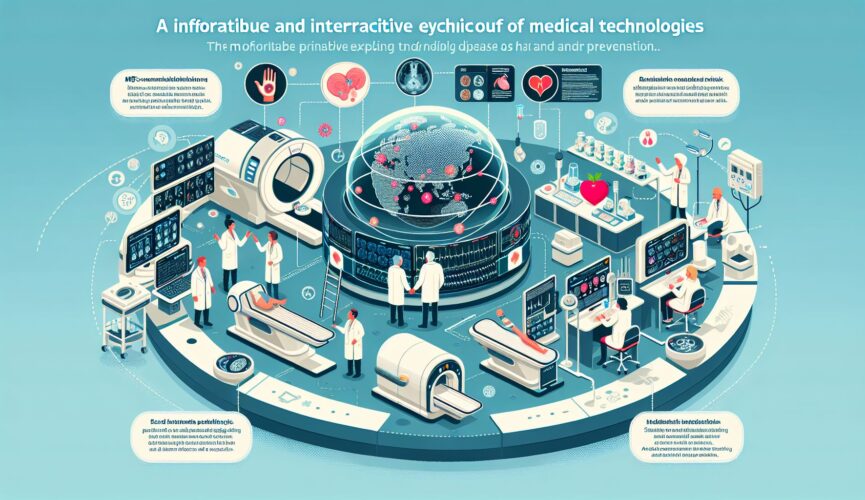Imagine a world without medical technologies that save lives. A place where diseases and illnesses were left unchecked, and hope for a healthy future was uncertain. Fortunately, advancements in healthcare have revolutionized the way we understand diseases and prevent them. From diagnostic tools to innovative treatments, these medical technologies have become indispensable assets in maintaining our well-being. In this article, we will explore some of these life-saving technologies and how they have shaped the landscape of modern medicine.
The Power of Diagnostic Imaging
One of the crucial aspects of disease prevention and treatment lies in early detection. With the advent of diagnostic imaging technologies, such as X-rays, CT scans, and magnetic resonance imaging (MRI), medical professionals can now visualize the internal structures of our bodies with utmost precision. These non-invasive procedures have revolutionized the way doctors identify diseases and make informed decisions about treatments.
For instance, a routine chest X-ray can help detect lung cancer at its earliest stages, when it is most treatable. Similarly, an MRI can provide detailed images of the brain, enabling neurologists to diagnose conditions like tumors, strokes, and multiple sclerosis. These technologies have not only saved countless lives but have also minimized invasive procedures, reducing patient discomfort and recovery time.
Breakthroughs in Genetic Testing
Our genes hold remarkable information about our inherited traits, as well as potential vulnerabilities to certain diseases. Thanks to genetic testing, medical professionals can now analyze our DNA for any genetic variations or mutations that may increase our risk of developing specific conditions. This innovative field of medicine, known as genomics, has opened doors to proactive disease prevention and personalized treatments.
By identifying genetic markers associated with diseases such as breast cancer, Alzheimer’s, or cystic fibrosis, individuals can be better informed about their risk factors and take appropriate preventive measures. Additionally, genetic testing plays a crucial role in prenatal care, helping expecting parents identify any potential genetic abnormalities in their unborn child. Armed with this knowledge, healthcare providers can devise tailored plans of action to ensure the best possible outcomes for both mother and child.
Remote Patient Monitoring
In an increasingly interconnected world, medical technologies have also ventured into the realm of remote patient monitoring. This innovative approach allows healthcare professionals to keep a close eye on patients, even when they are not physically present in a hospital or clinic setting. By utilizing wearable devices, patients can monitor their vital signs and health metrics in real-time, providing valuable data to their healthcare providers.
For chronic disease management, remote patient monitoring offers immense benefits. Diabetics, for example, can use continuous glucose monitors to track their blood sugar levels and adjust their insulin doses accordingly. Similarly, individuals with cardiovascular issues can employ wearable heart rate monitors to alert their doctors of any irregularities. The timely identification of such anomalies allows for prompt interventions, potentially saving lives and minimizing the risk of complications.
Cutting-edge Robotic Surgery
The field of surgery has witnessed remarkable advancements in recent years, and at the forefront of these innovations is robotic-assisted surgery. With the assistance of robotic systems, surgeons can now perform complex procedures with enhanced precision, flexibility, and control. By using miniature, wristed instruments and a magnified, high-definition 3D camera, surgeons can access tight spaces in the body with unparalleled dexterity.
Robotic surgery has revolutionized various procedures, ranging from minimally invasive surgeries to delicate interventions. For instance, in cardiac surgery, robotic systems allow surgeons to perform intricate repairs with utmost precision and minimal trauma to the patient. Similarly, in urological procedures, robots guide surgeons in removing tumors or reconstructing organs, greatly reducing the risk of complications and improving patient outcomes.
The Future of Medical Technologies
As medical technologies continue to evolve, the future holds even more promises for disease understanding and prevention. Breakthroughs in artificial intelligence, for example, are poised to revolutionize medical diagnosis by analyzing vast amounts of patient data and identifying patterns that may elude human perception. Additionally, advancements in nanotechnology will allow for targeted drug delivery, minimizing side effects and maximizing treatment efficacy.
The world of healthcare is advancing at an unprecedented pace, and harnessing the power of these technologies is vital not only for medical professionals but also for consumers. By educating ourselves about these life-saving innovations, we become active participants in our own well-being, taking advantage of the tools available to us in disease prevention and management.
In conclusion, medical technologies have revolutionized the way we understand diseases and how we prevent them. Diagnostic imaging, genetic testing, remote patient monitoring, and robotic-assisted surgery are just a few examples of the life-saving tools that have become essential in modern medicine. With each new breakthrough, the world moves closer to a future where diseases are better understood, prevention is more effective, and lives are saved. By embracing these advancements, we empower ourselves to take charge of our health and live longer, healthier lives.
